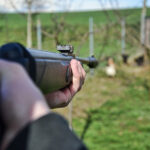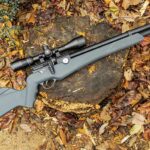In the 1970’s I had a subscription to Guns & Ammo magazine. In those dark days before the advent of the internet men would actually learn about the latest trends in the firearms world by looking at inked letters on actual pieces of paper bound in magazine form and dropped into their mailbox once a month. If, like me, they read the magazine cover to cover the day it was delivered, well, it was another four weeks reading back-issues until another fresh one arrived. Unlike today, where a voluminous amount of information is available 24/7 on line. Today the term “Scout Rifle” is well known to most people versed in firearms nomenclature, but if hard-pressed to explain its origins they would draw a blank. Enter, Col. Jeff Cooper, the former Marine officer/ firearms instructor/author, who had a column in the aforementioned Guns & Ammo magazine. In the 1980’s Cooper began writing about what he termed “the scout rifle concept”. He held a conference attended by other shooters and builders, where they pooled their years of experience, fleshing out what works and what doesn’t, all in the pursuit of what constitutes the most near to perfect rifle for general purpose use. Below are the parameters Cooper and the conference came up with after much deliberation, drawing inspiration from several sources, specifically the Mannlicher-Schönauer of 1903 and the Winchester Model 1894. Distinguishing characteristics of a scout rifle are:
Caliber: .308 Winchester/7.62×51mm NATO or 7mm-08 Remington for locales that forbid civilian ownership of cartridges in chamberings adopted by military forces or for its “slightly better ballistics.” As Cooper wrote, “A true Scout comes in .308 or 7mm-08.” Cooper had his “Lion Scout,” chambered in .350 Remington Magnum. I personally would have went with the .358 Winchester because it is based on the .308 case, with a neck blown out to .35 caliber.
Action: Cooper’s prototype scout rifles were all bolt-actions. He did say though that “if a semiautomatic action were made which was sufficiently compact and otherwise acceptable, it should certainly be considered”. Of the actions out there at the time Mr. Cooper considered the Brno ZKK 601 action to be the closest to the guidelines. A bolt-action two-lug, 90° rotation was favored. So too the Mauser claw extractor. The safety should be positive and include three positions. It should disconnect the trigger mechanism rather than blocking it. It shouldalso work from front to rear, rear position “safe” and forward “fire.”
Trigger: A crisp 3lb release. Cooper had his Steyr adjusted to 2 1/2lb.
Weight: unloaded with accessories -3 kg (6.6 lb) and 3.5 kilograms (7.7 pounds) the maximum acceptable.
Length: overall length of 1 meter (39 inches) or less. The weight and length parameters place Scout Rifles in the class of carbines.
Optics: a forward-mounted telescopic sight of low magnification, typically 2 to 3 power. This preserves the shooter’s peripheral vision, keeps the ejection port open to allow the use of stripper clips to reload the rifle, and eliminates any chance of the scope striking one’s brow during recoil. Scopes are NOT mandatory though.
Reserve sights: ghost ring auxiliary iron sights: a rear sight consisting of a receiver-mounted large-aperture thin ring, and a square post front sight on the receiver bridge and not on the end of the barrel, where it catches on things, breaks, snags and muddies up. This allows the rifle to be accurately aimed at short to medium ranges even if the scope becomes damaged.
Stock: synthetic rather than wood stocks. Heel of the butt rounded to avoid snagging on the shirt. A spare magazine stored in the butt. A retractable bipod that does not protrude from the stock.
Magazine: magazine should be so constructed as to protect the points of soft point spitzer bullets as they ride in the magazine. Some sort of magazine cutoff permitting the rifle to be used in the single-shot mode with the magazine in reserve. As an alternative to the magazine cutoff is a detachable box magazine with a double intent which could be inserted to its first stop not allowing the bolt to feed it. When desired, the magazine could be pressed into its second stop, permitting the bolt to pick up the top cartridge.
Sling: a “Ching” or “CW” sling. Cooper recommended the use of a sling as a shooting aid. The Ching sling offers the convenience of a carrying strap and the steadiness of a target shooter’s sling with the speed of a biathlete’s sling. (The CW sling is a simpler version of a Ching sling, consisting of a single strap.)
Accuracy: should be capable of shooting into 2 minutes of angle or less (4″) at 200 meters/yards (3 shot groups) These features dictated short, thin barrels, synthetic stocks, and bolt actions. Other optional features included a retractable bipod, detachable magazines, a butt magazine, and an accessory rail for lights and other attachments. The addition of some of these features often render the rifle technically not a scout as originally defined, but this has come to be accepted by many as still conforming to the spirit if not the letter of the concept.
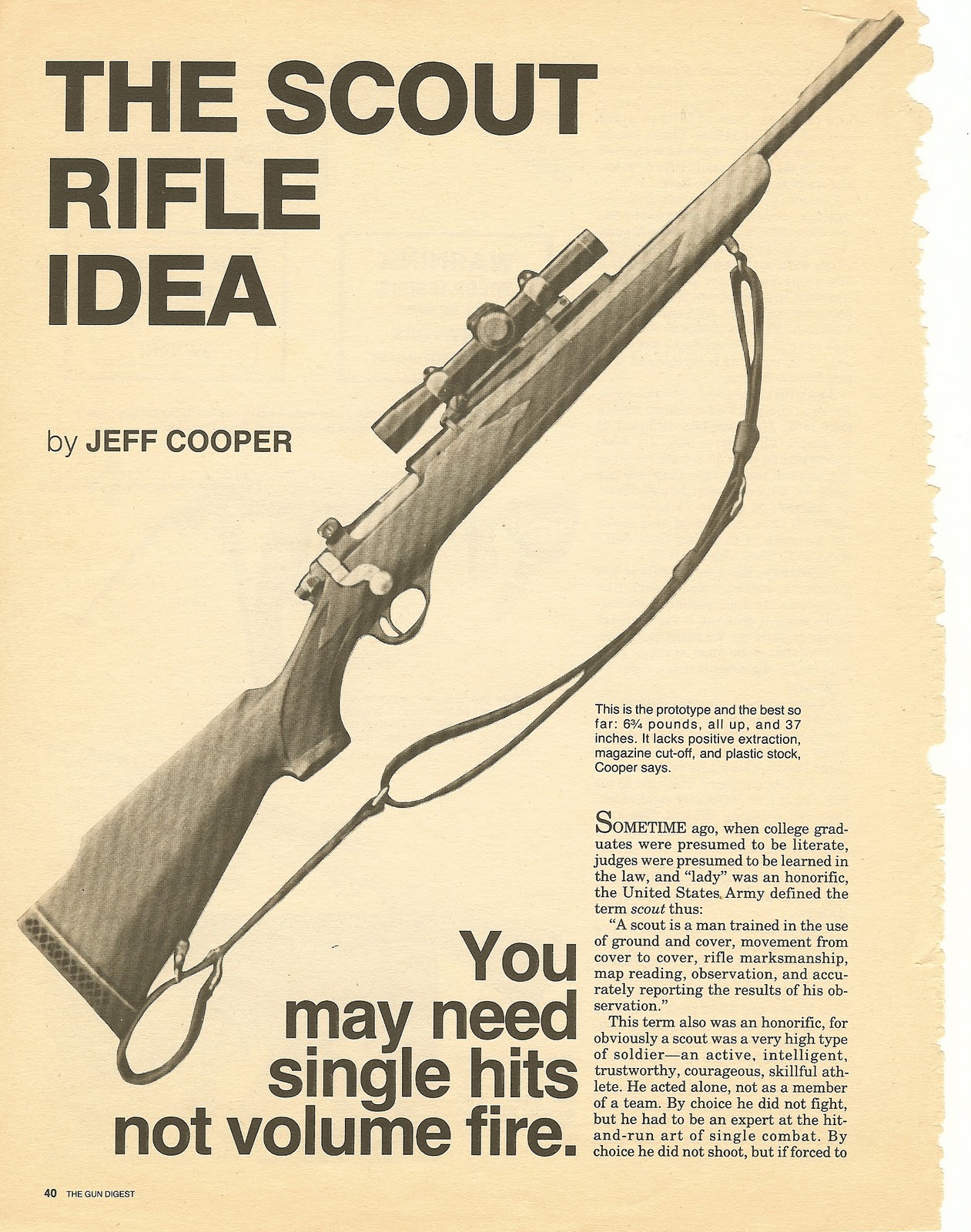
Cooper at this time was already operating the Gunsite Academy in the desert of Arizona just outside Paulden. I had the pleasure of attending two classes there in the 1990’s along with the privilege of having Jeff Cooper as an instructor. The school had world glass gunsmiths on campus who built Cooper the very first experimental Scout Rifles according to his specifications. Jeff would then write about their performance in the field in his Guns & Ammo column, where I was following the development of the “concept” in its incipient stage. These articles inspired custom builders to follow suit and start offering custom Scout Rifles to their customers. I had a friend at the time that had a pseudo-Scout built on a Mauser 98 action. The term pseudo-scout refers to rifles that adhere to some but not all of the criteria laid down at the Gunsite conference. This particular rifle followed many of the guidelines but was well over the 3kg / 6.6 lbs. due to the massive M98 action.
Here is an example of a well executed custom Scout Rifle built by Tim Cronin in Kalispell, Mt.
In the early 1990’s, after meetings between the Colonel and representatives from the Austrian firearms manufacturer Steyr, the company introduced the first true Scout Rifle on a production basis, and it was a beauty. I shot my first Elk on the Idaho-Montana border with a Steyr Scout, experiencing all the benefits I had been only reading about for over a decade. The rifle was extremely light to carry in the field. I had only seconds to get on target, the animal crossing over a ridge I was walking on, ready to descend into the timber on the other side. The rifle snapped to the shoulder smoothly allowing me to quickly acquire the post in the forward mounted scope. After firing I racked the bolt, shucking another cartridge into the chamber, but it was unnecessary, the .308 round had done its job cleanly and effectively.
Other manufacturers saw the potential in the Scout Rifle concept and began to offer their own versions. Savage was the first with what has proved to be a very good, if not perfect iteration, of the Scout Rifle ideal.
Ruger too, introduced what they, in collaboration with Gunsite, called the Ruger Gunsite Scout. It, like the Savage, meets many of the requirements of a Scout Rifle but is not in the same category as the Steyr. But then again, it doesn’t cost nearly as much as the Austrian import.
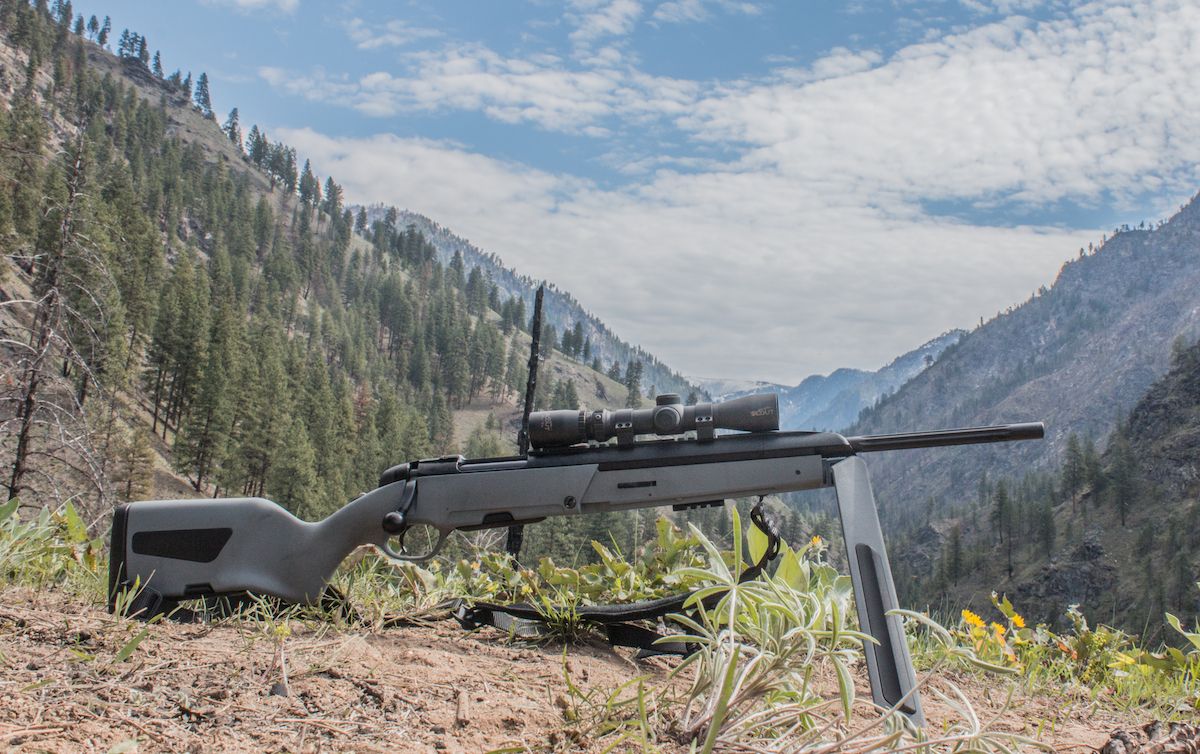
And recently the Tikka T3 Arctic, shown below, a rifle heavily influenced by the Scout Rifle concept, and one that incorporates many of its key features, was adopted by the Canadian Rangers. This is the first time a military unit has adopted the design, and it is one that places very high demands on a rifle due to the arctic conditions they operate in. Canada ordered 6500 T3 Arctic’s from Tikka, a subsidiary of Sako of Finland. The adoption of this pseudo-scout design by a Government further validates Cooper’s vision.
Springfield Armory has marketed a semi-auto version of the Scout Rifle. Based on the M1A, the Springfield is a pseudo-scout due to its being well over weight, 8.8 pounds w/o an optic, whereas the guidelines specify 6.6 pounds with optic. Many shooters like the short carbine-like feel of the Springfield with its 18″ barrel.
Cooper knew fine rifles and was very proud to have the maker of the Mannlicher-Schönauer producing his brainchild, with his name attached to it. Although Jeff passed away in 2006 he lived to see his concept take root firmly in the firearms world. Though American manufacturers and many custom builders have produced their versions of the Scout Rifle, it was the Steyr that was the feather in his cap. If he had lived to see the placing of red-dot sights on Scouts I think he would have resisted anything that takes batteries, but the Trijicon TA47-C-400146 would most likely have gotten his approval. It is extremely light, requires no batteries, extremely rugged, is designed for forward mounting, and is EXTREMELY EXPENSIVE, and Jeff liked quality, regardless the cost.
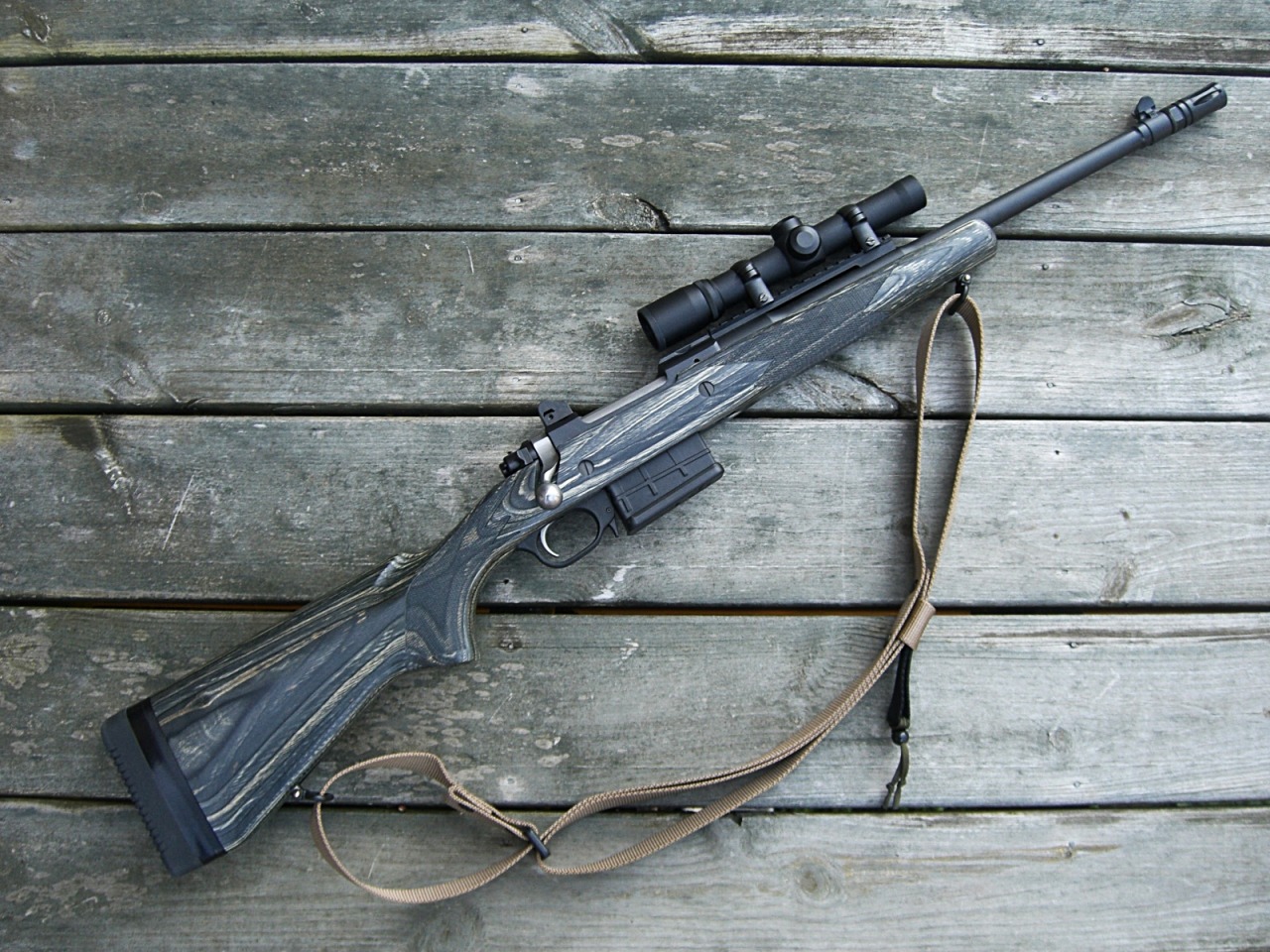 Here is a photo of Jeff Cooper and Steyr’s Heinz Hambrusch with the first production Steyr Scout Rifle.
Here is a photo of Jeff Cooper and Steyr’s Heinz Hambrusch with the first production Steyr Scout Rifle.
The subtitle to this article was “It’s here to stay,” referring to the Scout Rifle in all its forms, custom and factory, the pseudo Scouts and the orthodox versions. Jeff Cooper has had a lasting influence on firearms development. Interstingly, he was not a firearms designer or a gunsmith, he was a historian, a teacher, and an innovator. And being a keen observer with a good memory he stored ideas in the back of his mind, waiting to collate them into a unified, coherent, unit. The Scout Rifle is that unit, and it utilizes many of the ideas squirreled away by Jeff along the way. The handy size of a 1903 Mannlicher-Schoenauer for instance, the CW sling technique, which is merely a variation on an old British practice.
Original Mauser K98ks equipped with low-power, long-eye-relief scopes.
Even the forward mounted, long eye relief scope seen above goes back to WWII, a German development. A magazine cut-off was included on the .03 Springfield. Etcetera. What Jeff Cooper did was combine all of these time-proven features found at different times on diverse firearms, into one rifle; a general purpose rifle. They’re not for everybody. It may sound a bit presumptuous but it seems people with experience actually carrying, shooting, and hunting with rifles, rather than just reading about them and looking at them, appreciate the benefits the Scout Rifle design offers. Let’s face it, if the engineers at Steyr, Savage, Ruger, and Springfield, in addition to the dozens of custom builders that make Scout Rifles, didn’t see the value and utility in the design, they wouldn’t be making them. The fact of the matter is, it works, and it works well, meaning, the Scout Rifle will be around for a long time to come.












































